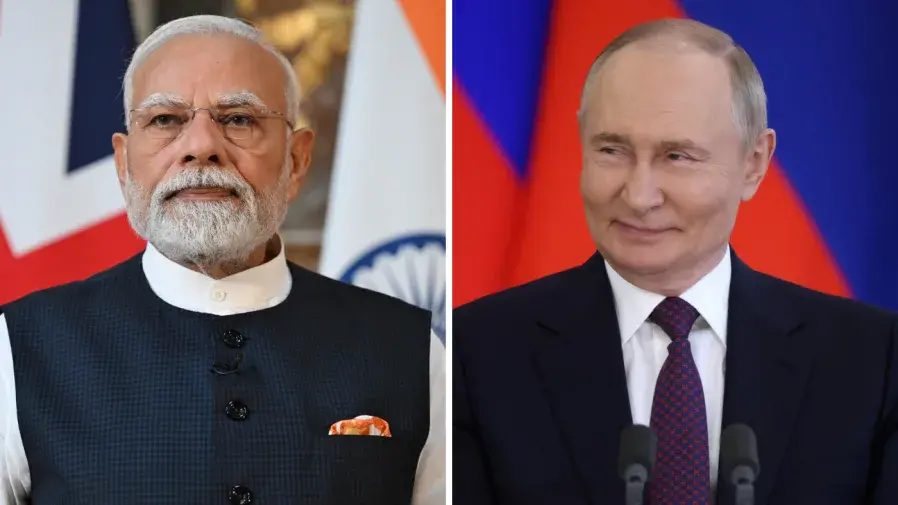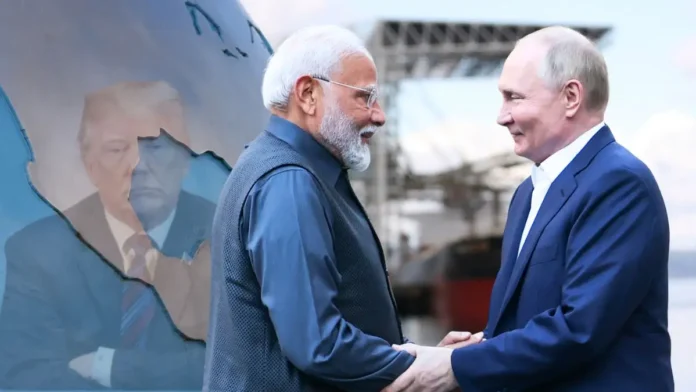After Trump’s tariffs on India, Modi and Putin agreed to deepen their strategic partnership. They plan to expand cooperation in energy, defense, and trade, reinforcing India–Russia ties and safeguarding strategic autonomy despite mounting economic and political pressure from the United States.
KumDi.com
Following steep U.S. tariffs imposed by Donald Trump, Prime Minister Narendra Modi and President Vladimir Putin have pledged to deepen the India–Russia strategic partnership. This move underscores their shared commitment to energy, defense, and trade cooperation despite global economic tensions.
In a decisive moment for international diplomacy, Prime Minister Narendra Modi and President Vladimir Putin have reaffirmed their commitment to a “Special and Privileged Strategic Partnership” just days after the United States imposed steep 50% tariffs on Indian exports. The move by former President Donald Trump marks one of the most significant trade escalations between Washington and New Delhi in recent years.
For India, this sudden tariff shock has not only economic consequences but also deep geopolitical implications. Modi’s response — engaging directly with Putin to strengthen energy, defense, and trade ties — is a clear signal that India will not bow to external pressure when it comes to safeguarding its national interests and strategic autonomy.
This article unpacks the events leading up to this renewed partnership push, the sectors likely to benefit, and what it means for global geopolitics.
Table of Contents

The U.S. Tariff Shock: How We Got Here
The seeds of the current tariff dispute were planted long before August 2025. India’s growing imports of discounted Russian crude oil — a lifeline for keeping domestic fuel prices under control — have long been a sore point in Washington.
In early 2025, the Trump administration slapped a 25% tariff on several categories of Indian exports, citing India’s refusal to scale back its Russian oil purchases as “undermining U.S. sanctions policy.” By August, the rate was doubled to 50%, affecting sectors from textiles to pharmaceuticals and IT services.
While Trump’s political base praised the move as “tough on trade,” critics argued that the tariffs risked alienating one of America’s most important strategic partners in Asia.
India’s Response: Strategic Autonomy in Action
India’s foreign policy has long been guided by the principle of strategic autonomy — the ability to make independent decisions without aligning rigidly with any single power bloc.
Rather than yielding to U.S. pressure, Modi’s government responded by strengthening ties with Moscow. This not only serves as an economic counterbalance to lost trade revenues from the U.S., but also reinforces India’s multi-aligned foreign policy approach.
By reaching out to Putin within days of the tariff announcement, Modi signaled to both domestic and international audiences that India’s partnership with Russia is not negotiable.
The August 8 Modi–Putin Call: Key Takeaways
The detailed phone conversation between Modi and Putin covered several strategic areas:
- Energy Cooperation – Continuing and possibly expanding discounted oil imports.
- Defense Collaboration – Exploring new arms procurement and joint production deals.
- Trade Diversification – Identifying sectors for tariff-free trade growth.
- Ukraine Conflict Updates – Sharing perspectives without compromising India’s neutral stance.
- Future Summit Planning – Confirming Putin’s expected visit to India before the end of 2025.
One of the call’s most symbolic elements was Modi’s formal invitation to Putin for an in-person visit — likely to coincide with the 23rd India–Russia Annual Summit.
Energy: The Cornerstone of Cooperation
Energy security remains the most significant driver of the Modi–Putin relationship. Since 2022, India has increased its intake of Russian oil several times over, taking advantage of discounted rates.
This has provided critical relief to India’s economy, helping keep inflation manageable and ensuring a steady supply of crude amid volatile global markets. For Russia, India offers a dependable and growing export market at a time when Western buyers have drastically reduced purchases.
By deepening energy ties, both countries create a mutually beneficial shield against Western economic sanctions and market instability.
Defense: Beyond Buyer–Seller
India is one of Russia’s largest defense customers, with decades of cooperation on aircraft, naval systems, and missile technology. Notable recent acquisitions include the S-400 missile defense system, which drew criticism from the U.S. under the CAATSA sanctions regime.
The August call is believed to have included discussions about:
- Co-development of next-generation fighter aircraft.
- Expansion of joint naval exercises.
- Technology transfer in hypersonic missile development.
- Cybersecurity and space cooperation.
These projects would not only modernize India’s defense capabilities but also anchor its military supply chain in a trusted partnership.
Trade Diversification: Reducing U.S. Dependence
The tariff crisis underscores the importance of trade diversification for India. By expanding bilateral trade with Russia — especially in sectors like agriculture, fertilizers, and rare earth minerals — India can offset losses from reduced access to U.S. markets.
Potential trade growth areas discussed include:
- Pharmaceutical Exports – India as a supplier of affordable generics to Russia.
- IT Services – Collaboration in AI, fintech, and cybersecurity.
- Manufacturing – Joint ventures in automotive and heavy machinery sectors.
The Ukraine Question: Walking the Diplomatic Tightrope
While many nations have taken clear sides in the Ukraine conflict, India has maintained a position of principled neutrality. Modi has repeatedly called for dialogue and de-escalation while refraining from directly condemning Moscow.
This careful balancing act allows India to maintain diplomatic credibility with both the West and Russia, and positions it as a potential mediator in the future.
Putin’s Expected Visit: Why It Matters
Putin is expected to visit India before the end of 2025, though the exact dates are still being negotiated. The visit will likely produce announcements in:
- Long-term energy contracts.
- Defense co-production agreements.
- High-technology cooperation in nuclear energy and space.
- Cultural and educational exchanges.
From a geopolitical standpoint, the optics of Putin being welcomed in New Delhi — just months after a major tariff clash with the U.S. — will be a powerful symbol of India’s independent path in world affairs.
Strategic Autonomy as the Guiding Principle
At its core, the Modi–Putin partnership reaffirms India’s doctrine of strategic autonomy. In a multipolar world where alliances shift rapidly, India’s ability to engage with diverse partners on its own terms is its greatest strength.
By deepening ties with Russia in the face of U.S. tariffs, India sends a clear message: partnerships will be built on mutual benefit, not coercion.
Conclusion: The Road Ahead
The coming months will reveal how far Modi and Putin are willing to take this renewed partnership. Opportunities include:
- Securing favorable energy deals.
- Expanding high-tech and defense cooperation.
- Building a resilient bilateral trade framework.
Challenges remain, particularly managing U.S. relations while reinforcing Russia ties. But for now, India appears committed to walking its own path, tariffs or not.

FAQs
Why are Modi and Putin deepening their partnership after Trump’s tariffs?
They aim to strengthen India–Russia strategic ties in response to U.S. tariffs, focusing on energy, defense, and trade cooperation.
How do Trump’s tariffs affect India–Russia relations?
The tariffs have pushed India to reinforce ties with Russia, ensuring stability in energy supplies and military cooperation.
Will Putin visit India in 2025?
Yes, Putin is expected to visit India by the end of 2025 to finalize agreements in energy and defense sectors.
What role does energy play in the Modi–Putin partnership?
Energy is central, with India importing discounted Russian oil to ensure economic stability despite U.S. pressure.
How does this partnership impact India’s strategic autonomy?
By deepening ties with Russia, India maintains strategic independence while balancing relations with the U.S. and other powers.




